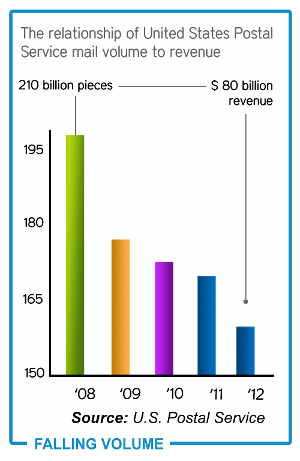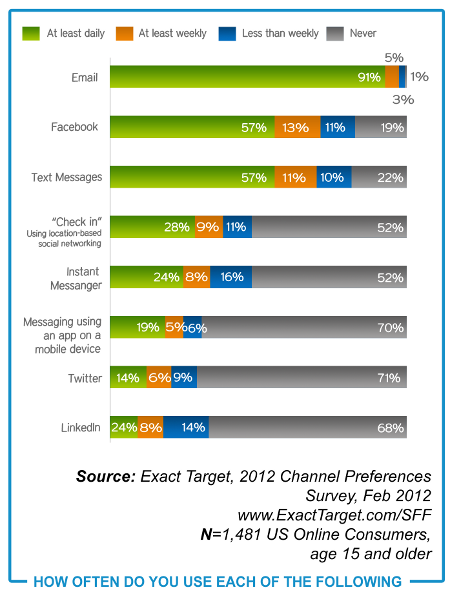- No more Saturday delivery of letters and magazines as of August 1, 2013 1
- Loss of $15.9 billion in the last budget year 1,3
- Default on $11 billion retiree health benefits prepayments last year 1,2,3
Even more startling:
The Postal Service can't borrow more money from Congress to save itself, because it reached its debt limit in 2012. Without a solution by October 2013, USPS CFO Joseph Corbett warns the service could go bankrupt. 3The facts are obvious. Mail volumes are decreasing (this graph tells the story) and the USPS is in financial tatters.
If the Postal Service disappeared this October, how would your company continue to deliver its bills, statements, policies, notices, and other documents in a timely fashion?

POSSIBLE SOLUTION: eDocuments via website portal?
Nearly every utility, bank, insurer, and lender has a customer website portal. A place where a customer can register, chose a username and password, and then interact with the company for self-service options.
From this point forward the customer can receive their documents electronically, right? Nothing else they have to do right? Wrong! The electronic document never actually gets delivered, instead they have to “fetch” the document from the website by using, possibly, the 7th username and password combination he/she created in the last few months. This begs the question: How does this replicate the ease of receiving paper mail at home?
And then there's the case of the forgotten password, where the customer has to make a call to the service center (cost). This wipes away the paperless savings a company would have earned. Plus no payment yet, as the customer is not logged in.
The problem: Documents are not 'delivered' via a website. Registering on a website is like having to open a PO Box at the post office. In both cases your documents don't get sent directly to you. Instead they are sent to a secure holding facility where you need a key or password to retrieve. If only a fraction of Americans have a PO Box, expect only a fraction of your customers to go paperless through your website.
The actual rates are likely worse than you think. Here are the paperless adoption rates as of Dec 2011 4
* Insurance 8% * Utility 12% * Mortgage 16% * Cable 18% * Credit Cards 20%
BETTER SOLUTION: eDocument delivery via email
According to Exact Target, 91% of online consumers check their email inboxes daily. A smartphone owner is more likely to use the device for email than a phone call 5. I bet you've checked your inbox via your phone or PC, either before or after reading this blog. Fact is; the email inbox is a digital mailbox that can be peeked into anywhere and at anytime. So, why don't companies send documents directly to their customers' email inboxes? Wouldn't that best replicate the service the USPS provides in the paper world?
The good news is; some companies are. By using encrypted PDF technology and a shared secret to authenticate security, some of the biggest brands around the globe are delivering an exact replica of the bill, statement, policy, or notice directly to the customer's inbox. No registration, no username / password, and no inconvenience. Without any additional work, a customer can go paperless via a process that actually mirrors what the USPS does on a daily basis. Even better, the secure PDFs are interactive, allowing customers to make a payment, change personal information, or link to a website directly from the PDF. No more paper, much faster payments, and a superior customer experience.

If you would like to know more about the champions of email eDocument delivery, I encourage you to check out ourwhite papers and case studies. Email inbox - the obvious replacement for the postbox
And for added convenience you can also contact us directly.
References:
1. Do We Really Want to Live Without the Post Office?
2. Understanding the Post Office’s Benefits Mess
3. USPS Cutting Saturday Mail Delivery
4. eBilling Benchmarking Study by Blueflame Consulting sponsored by NACHA 2011
5. Smartphone owners more likely to read emails than make calls: stats
Chad Somodi
striata.com
No comments:
Post a Comment